Pula
A brief history of a city and what not to miss
Pula is one of the most dynamic Croatian centres in Istria, the small triangular peninsula bordering the northern waters of the Adriatic Sea, and is known, like the rest of the Istria region, for its mild climate, calm sea and unspoiled nature.
Like any seaside town, its history is a layering of different peoples, traditions, constructions and bombings, making it one of the most interesting centres in the entire area.
Pula and its Arena
Although a legend says that the first inhabitants of Pula were Jason and the Argonauts, the actual founding of the city took place thanks to the Romans, who conquered the area in 177 B.C. and built the city around 46 B.C. as a colony of Roman citizens (known then as Pietas Iulia).
The city’s glorious Roman past can still be felt as you stroll through its streets, dotted with emblematic monuments, first and foremost its amphitheatre, the best-preserved ancient monument in Croatia.
The amphitheatre, also known as the Arena of Pula, dominates the entire city centre and is its most iconic symbol. It is the sixth largest surviving amphitheatre and was built between 2 B.C. and 14 A.D. at the behest of the first emperor, Augustus.
However, the shape we see today is the result of an extension ordered by Vespasian, the same emperor who built the Colosseum. Vespasian wanted the Arena to host gladiator fights that could be admired by 23,000 spectators.
The reasons for the Arena’s renovation
However, the story goes that the intention to bribe the public was not the only reason behind this renovation; there was a very personal one: to pay homage to a woman, Cenis, a native of Pula and the emperor’s official mistress.
The Arena, named after the Latin word harena (the sand on which gladiators used to fight) is the only one surviving today to preserve the square corner towers that characterised this type of building.
Here, aromatic water was stored in special cisterns, two per tower, which was used to supply some fountains or to be sprayed on people during hot days.
The amphitheatre was located just outside the Roman walls, on sloping ground, an inconvenience overcome by its architects with a basement higher towards the sea, on whichtwo levels of round arches supported by massive pillars and, above these, an attic, pierced by quadrangular openings, still stand today.
The entire building was made of limestone, unfortunately partly used in later centuries to construct other buildings in the area.
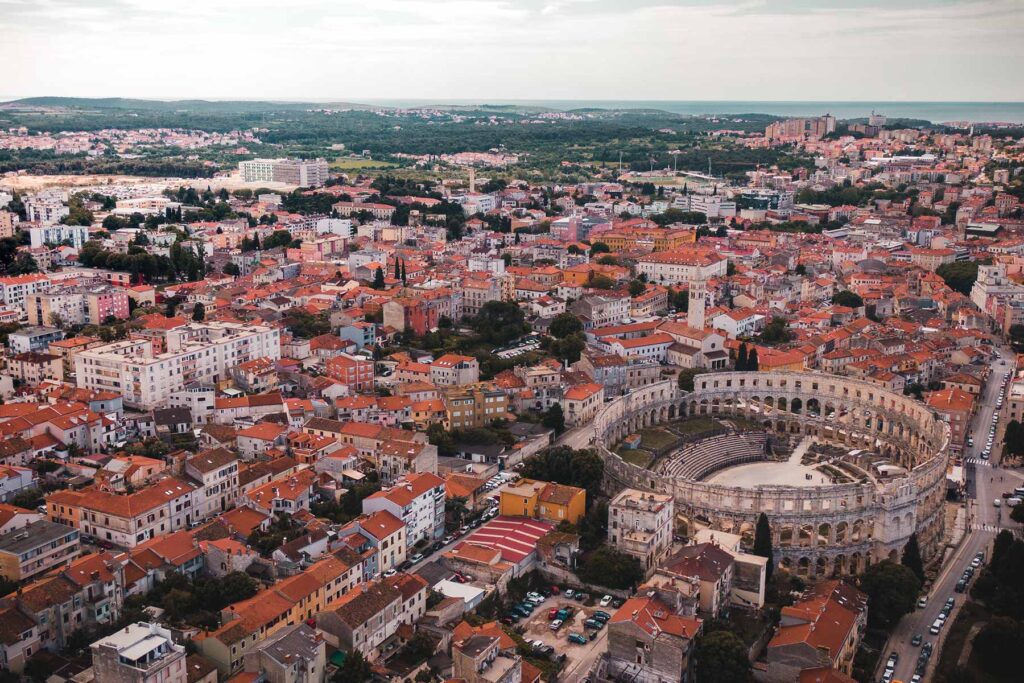
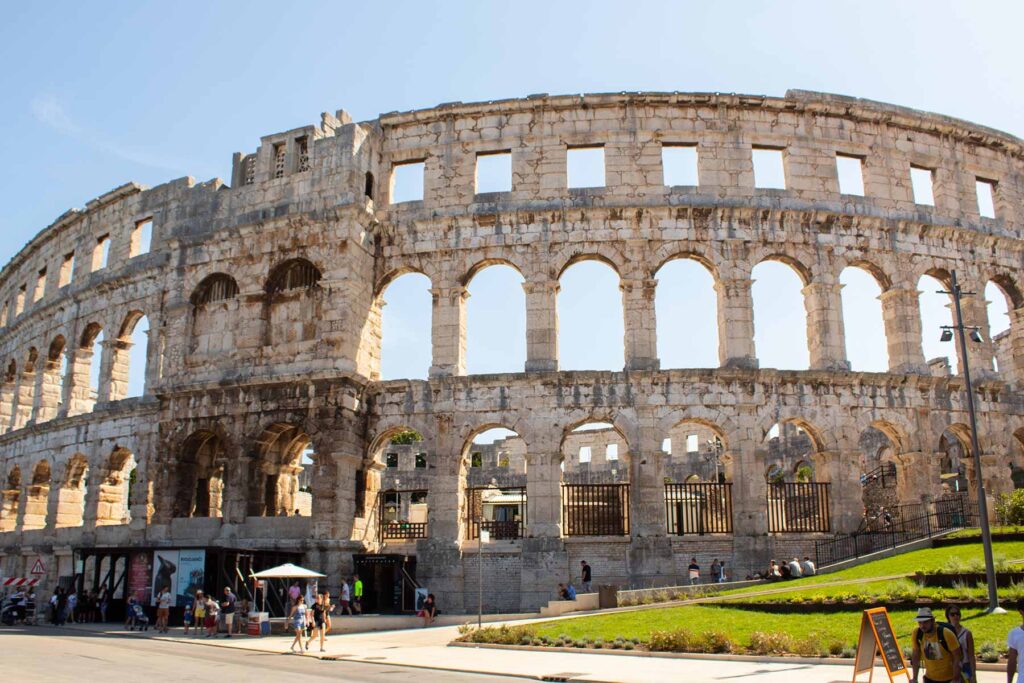
An interesting fact
In the Renaissance period, when the city was under the rule of the Venetian Republic, known as La Serenissima, some nobles even suggested
dismantling the entire amphitheatre stone by stone in order to rebuild it in Venice.
Fortunately, the Venetian senator Gabriele Emo vigorously opposed this, and the inhabitants of Pula, in order to thank him, dedicated a statue to him, which can still be admired near this imposing monument.
The Temple of Augustus
The Arena is not the only evidence that Pula was a flourishing city of the Roman Empire, with its lively harbour and ancient forum. One of the most important buildings of this area still exists today: the Temple of Augustus.
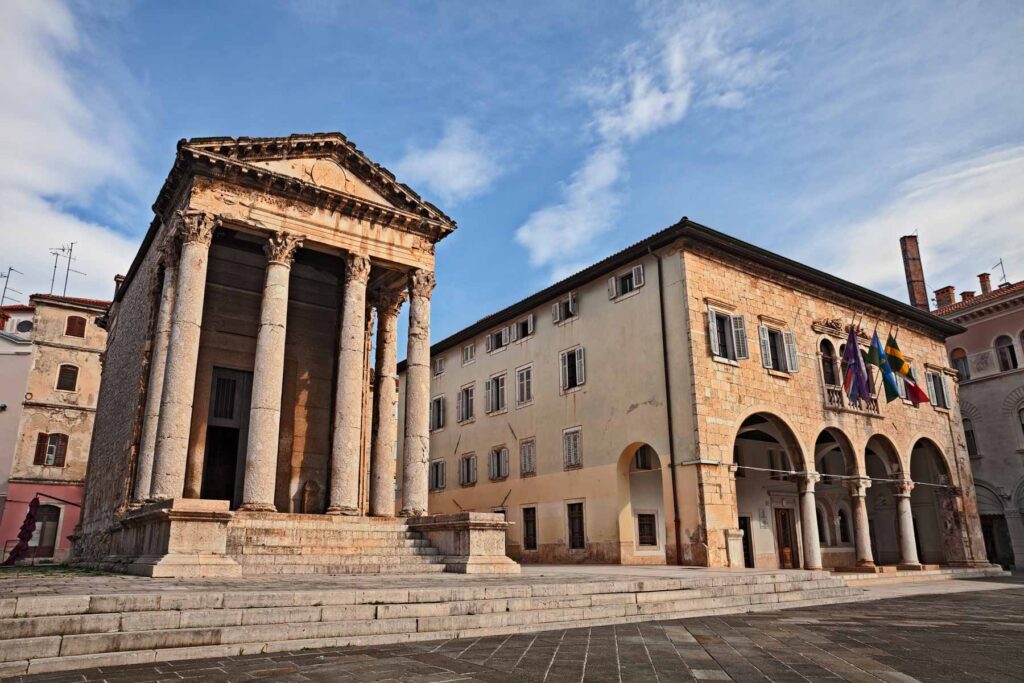
This elegant monument of soaring dimensions was built between 2 B.C. and 14 A.D. at the behest of Octavian Augustus, who had already commissioned the Arena.
The sacred building, with its fine Corinthian columns, experienced similar vicissitudes to those of the Parthenon in Athens: transformed into a church and then into a granary, it was eventually damaged by the Allied bombing raids during the Second World War, a period when the city was in the hands of the German army.
Fortunately, a careful restoration has fully restored its beauty.
The atrocities of war only in very rare and fortunate circumstances can bring benefits: this is the case of an extensive floor mosaic, discovered by the very same Allied bombs that collapsed part of the forum temple.
Its decoration sees an orderly alternation of geometric motifs and natural elements belonging to flora and fauna; however, among these more common subjects, the central panel of the left-hand section stands out, depicting the punishment of Dirce, a subject that was not very common in ancient times.
The triumphal Arch of the Sergii
There is one last Roman monument that deserves to be seen for its incredible state of preservation and for how much it has been loved over the years by artists, among them the famous Michelangelo Buonarroti.
This is the triumphal Arch of the Sergii; the matron Salvia Postuma had it built in honour of her husband Lucius Sergius Lepidus next to one of the city gates between 25 and 10 B.C., as the dedication inscription on the attic reads erected.
It is a single-arched arch, framed by two pairs of elegant, slender columns of Corinthian style. Its decoration is much more refined than that of the contemporary Arch of Augustus in Rimini: quadrigas, putti holding festoons laden with flowers and fruit, and the ever-present winged Victories, which have always been essential elements of this type of monuments.
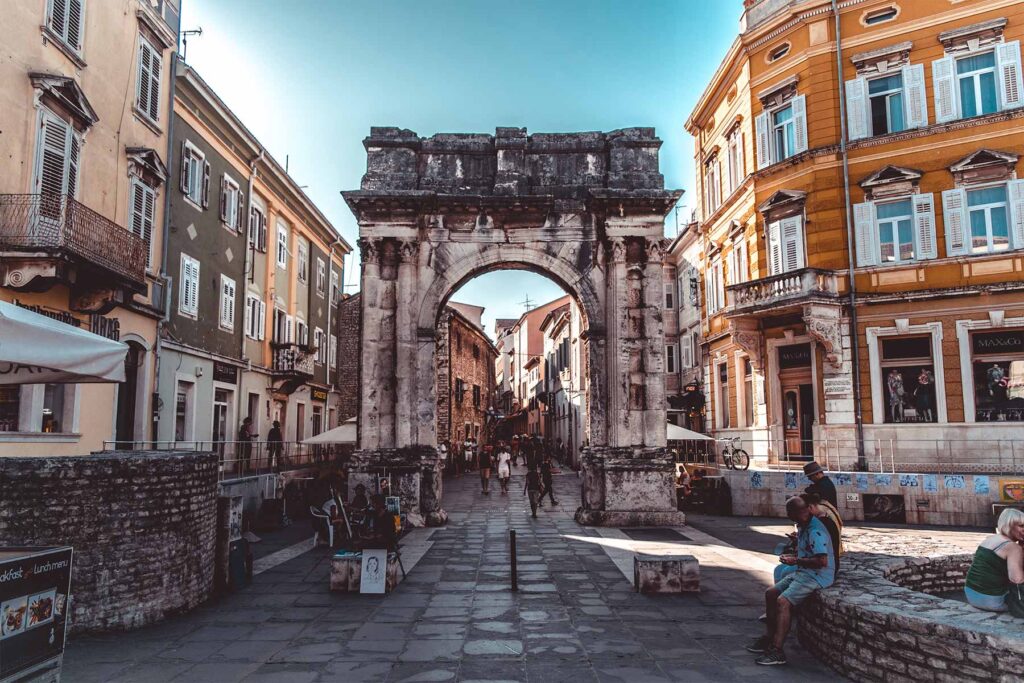
Not only treasures from Roman times
Pula does not only preserve artistic treasures from the Roman period. In the city centre, there are several monuments that testify to the Medieval period, Venetian rule, and later periods: Austro-Hungarian, Italian, Nazi and Yugoslav.
The Town hall and the Pula Cathedral
The Town hall, located in the Forum Square, which was repeatedly altered in the following centuries, and the Cathedral of the Assumption of the Blessed Virgin Mary, which was also enlarged and underwent several subsequent interventions, date back to the medieval period.
One of these, dated between 1671 and 1707, led to the construction of the bell tower, for which a large amount of material from the Roman Arena was used.
The Chapel of Santa Maria Formosa and the Monastery of St Francis
Two other sacred buildings should certainly be mentioned for their value: the first is the Chapel of Santa Maria Formosa, part of an abbey complex that was later demolished. It is one of the main early Christian monuments in Byzantine style in Istria, whose appearance was very similar to that of the Mausoleum of Galla Placidia in Ravenna.
It was inspired by this small Italian masterpiece, with the difference that for the Pula Chapel, stone and not brick was used as a building material.
The interior must have been extremely majestic, decorated with precious mosaics, the remains of which can be seen in the Archaeological Museum of Istria.
The second building worth mentioning is the Monastery of St Francis, whose church was built in the early 14th century and features the characteristic simple style of Franciscan complexes, with late Romanesque elements combined with Gothic decorative details.
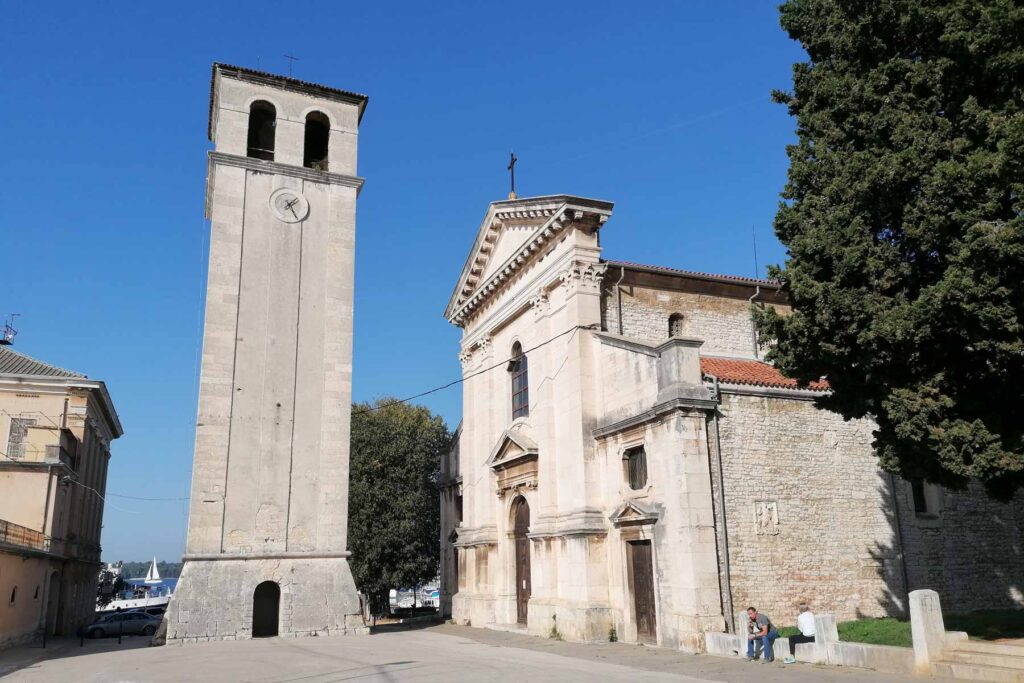
The Castle and the Fortresses
Moving on to the period when Pula was under Venetian rule, it is worth mentioning one monument of great importance, from which one can enjoy a stunning view of the city: the Castle, a Venetian fortress located on the top of the main hill overlooking the harbour.
Its quadrangular shape surrounded by four pike-shaped bastions was designed around 1630 by the French architect Antoine De Ville, commissioned by the Venetian government, which was interested in defending Pula, a centre of fundamental importance for maritime traffic in the Northern Adriatic, from possible external attacks.
This is not the only military monument in the city, there are several fortresses dating back to the Austro-Hungarian period that can be visited today; they were part of an efficient and complex defensive network designed to protect the most important military harbour in the empire. These include the Varudella fortress, reconfigured to house the city’s aquarium, the largest in Croatia.
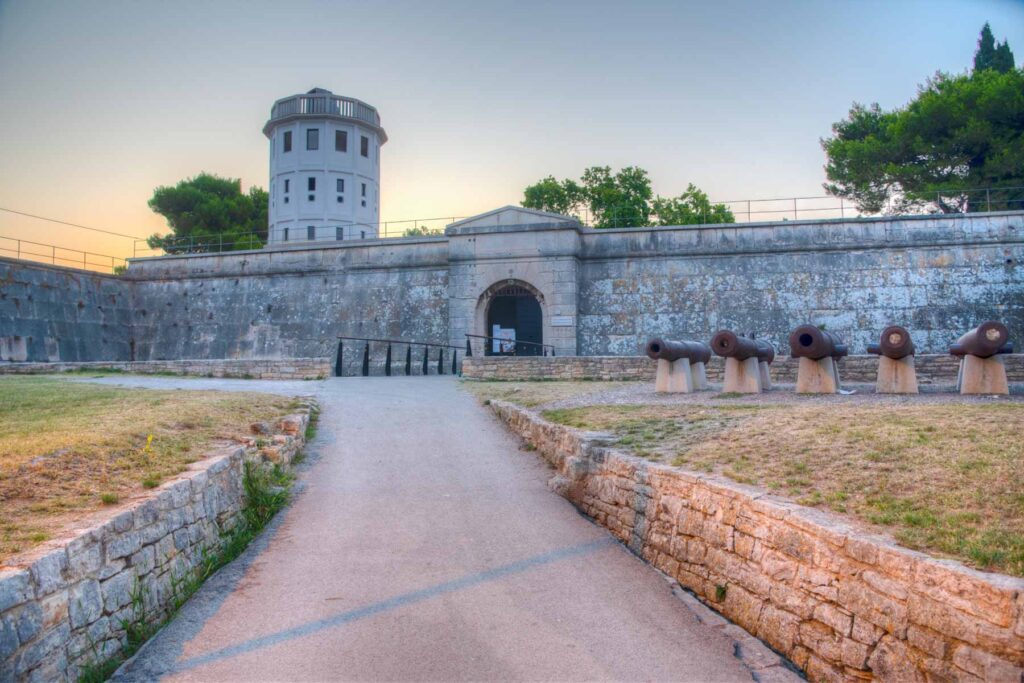
The statue of James Joyce
It is impossible to end this walk in search of the beauties of Pula without mentioning one of the last artistic masterpieces the city has endowed itself with. It is the bronze statue of James Joyce, placed between the tables of the café “Uliks” (Ulysses in Croatian) just like the title of his most famous novel.
The artwork, created by the famous Croatian sculptor Mate Čvrljak in 2003, pays tribute to the Irish writer who for a brief period of his life taught English just a few steps away from this café from which he continues to sip his coffee even today under the shadow of the Arena.
There would still be many details to be told about the city of Pula and its varied and unique heritage, but to really discover them, all you have to do is stroll through its streets, explore its museums, attend its events, and immerse yourself in its history.
BiVillage and the Brijuni Islands
The BiVillage, located in Fažana on the coast of Istria opposite the Brijuni Islands, is the ideal place for those who wish to explore this beautiful archipelago.
The village offers a wide range of tourist activities, including excursions to the Brijuni Islands.
This group of 14 islands was proclaimed a national park in 1983. Each island has its own natural beauty and the national park offers numerous activities for visitors, such as hiking, horseback riding, boat trips and scuba diving.
One of the most exciting attractions on the main island is the Safari Park, where visitors can see exotic animals such as zebras, elephants, etc.
In addition to nature and wildlife, the Brijuni Islands also offer a rich cultural history.
The first historical mention dates back to 384 AD and during the following centuries, the archipelago was inhabited by peoples such as the Romans and the Venetians. Throughout history, it was also used as a military base during World War I and as the summer residence of the Yugoslav President Tito in the 1950s and 1960s.
Today, the Brijuni Islands are an important tourist destination in Croatia, offering visitors an unparalleled experience of nature, culture and history.
The islands are easily accessible from the mainland and offer high-quality accommodation, restaurants and bars where you can enjoy local cuisine and fine Istria wines.
CHECK OUT THE BIVILLAGEThe author
Monika Petrović
Monika Petrović was born in 1979 in Pula.
She graduated in 2004 from the Faculty of Humanities and Social Sciences in Rijeka and also at the Department of Art, specialising in Painting in the class of Marijan Pongrac.
She works at the Archaeological Museum of Istria as a restorer of glass, ceramics and metals.
She is a member of the HDLU (Croatian Association of Artists) of Istria.
